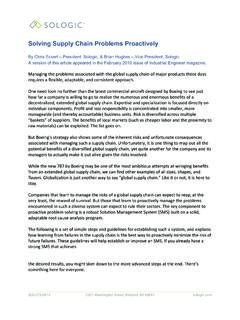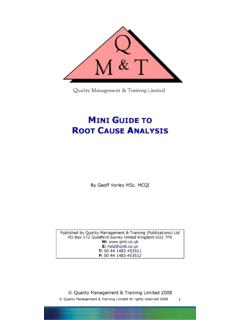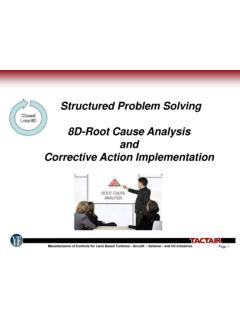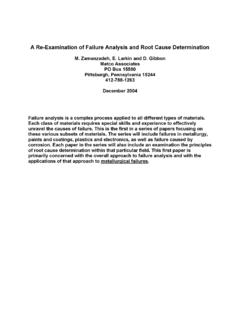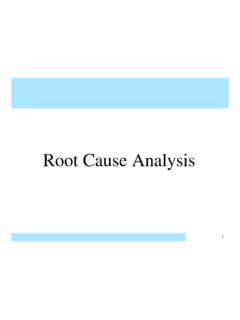Transcription of Root Cause Analysis Concepts and Best Practices …
1 800-375-0414 2501 Washington Street, Midland, MI 48642 root Cause Analysis Concepts and Best Practices for IT Problem Managers By Mark Hall, Apollo RCA Instructor & Investigator A version of this article was featured in the April 2010 issue of Industrial Engineer magazine. Many IT departments struggle with the negative business impacts of recurring problems, and many also struggle with how to proceed with formally investigating each major problem. The risks are so significant that IT related problems are estimated to impact the US economy to the tune of around $60 billion per year for software errors and around $140 billion per year for info/data security breaches. So how are solutions typically being developed for these problems? There seems to be a reliance on the statistical analyses of industry trends to drive IT related solutions. Information from actual IT problems categorized by type, or assumed Cause and solutions, are recommended based on data trends exhibiting the highest percentages or greatest threats.
2 This approach leads to one of the most common reasons problem solving is often ineffective solutions based on categories do not necessarily address the actual causes of a given problem as effectively as solutions that are specifically designed to control the actual causes of the problem. Categories don t Cause problems causes do. Categories are titles created so that similar things can be grouped together, so by nature are generic on many levels. Generic, categorical based solutions fail at a much higher rate than do solutions that control specific causes of a defined problem. The problem management component of the Information Technology Infrastructure Library (ITIL)1 framework sets the stage for each organization to adopt effective problem solving strategies that will improve the quality of internal and external IT services. Recently, IT organizations have begun to realize that some of the same problem solving best Practices long used by other disciplines such as quality, safety, maintenance and reliability are adaptable and scalable to IT.
3 Successful IT problem solving organizations are increasingly implementing formal root Cause Analysis (RCA) within their ITIL problem management structure. So, What is a Problem? In ITIL terminology, problems and incidents have unique definitions for IT related events. An IT 'problem' is the unknown Cause of one or more incidents, often identified as a result of multiple similar An incident is an unexpected event which negatively impacts the quality of IT service3. 1 ITIL Information Technology Infrastructure Library. 2 3 800-375-0414 2501 Washington Street, Midland, MI 48642 In more simplistic terms a problem is simply a deviation from a goal. An organization must have clear business goals that should be known to everyone inside. Otherwise an organization cannot effectively identify problems and efficiently allocate resources to solve them. Problems are relative to specific organizational goals.
4 An ad hoc approach to identifying organizational problems can lead to unstructured approaches to solving them, which can Cause the organization to waste time, money, resources and potentially experience recurring problems. Best Practice: Understand and communicate all organizational business goals. Establish Threshold Criteria to Help Prioritize Problems RCA is a tool that is used to solve problems that are preventing an organization from achieving its business goals. Threshold criteria are used to recognize and quickly define problems when they occur so that the overall response can also be right sized to the problem at hand. For each major business goal, target, or KPI, it is critical to establish formal written criteria that represent when the magnitude or direction of a deviation is far enough from the original goal that it warrants a formal investigation to prevent its recurrence. These threshold criteria need to represent the point where the cost of investigating and solving a problem are less than the cost of the problem.
5 For example, you may have a goal to prevent unscheduled network outages during business hours that last more than 15 minutes. If an event occurs during business hours that interrupts normal network service for less than 15 minutes, then the service is restored as quickly as possible. However, relative to the stated goal it was not severe enough to warrant investing time and resources for a formal RCA. Business goals can also be prioritized in order of importance so that the logic of recognizing and defining a problem is aligned with the relative importance of each goal to the organization. Best Practice: To ensure your formal RCA process is deployed in a timely and cost effective manner, make sure to use RCA to solve problems that have prevented, or could prevent, achievement of specific business goals. Customize Threshold Criteria Within each level of the organization you should have goals that are inter related so everyone is working toward achieving the same overall corporate goals.
6 At each level, establish threshold criteria to define what is considered a problem at that particular level. Those criteria will trigger RCAs only at the appropriate level of the organization. If the threshold criteria are set slightly lower for each level in the organization, this works toward compartmentalizing problems before they become problems at a higher level in the organization. 800-375-0414 2501 Washington Street, Midland, MI 48642 For example, a threshold for a corporate goal pertaining to cost control on a new infrastructure upgrade project might state that any unplanned cost expenditure greater than $500,000 is a problem at a corporate level. At a regional level, though, threshold criteria might be set at $400,000 for the same goal and $300,000, or even less, for the business unit, and so on. Threshold criteria are critical to ensure expenditures on RCAs are aligned with the overall organization goals.
7 These criteria should be fluid and change with shifting business climates or with individual organizational direction/situations. Formal threshold criteria give direction and purpose to your formal investigation programs. Best Practice: Create threshold criteria at all levels of the organization. What is root Cause Analysis ? RCA is a structured process designed to help people understand the causes of past problems for the purpose of preventing recurrence. It is step wise and structured so that it can be consistently applied to different problems at different times by different people. Solutions will only be effective if they act on the specific known causes of a defined problem. Best Practice: Adopt a robust formal RCA method. Avoid simplistic, generic or categorical methods like the 5 Whys , Fishbone diagrams or brainstorming because they are not as effective at identifying the causes of problems as the leading modern RCA methods are.
8 Instead, choose robust, principle based methodologies that dig deeply into the causes of problems and support known causes with factual evidence. root Cause Analysis Steps Effective problem solving has four primary steps. These steps must be followed in sequence. Jumping around or skipping a step will ultimately lead to failure in solving the problem 1. Define the problem 2. Create a causal understanding of the problem 3. Identify solutions that act on known causes of the problem 4. Implement the best solutions Best Practice: To ensure your formal RCA process is deployed in a timely and cost effective manner, make sure to use RCA to solve problems whose impacts meet or exceed your threshold criteria. Now we ll go through the RCA steps in detail. 800-375-0414 2501 Washington Street, Midland, MI 48642 Define the Problem What is the problem? When did it occur? Where did it occur?
9 What is the significance or impact ($) of the problem on the business? Thoroughly defining the problem includes formally pinpointing exactly what the problem is, when and where it happened, and the impact that it had on the business. Problems are defined by the most significant consequence of a major incident, or as the business goal, target, KPI or metric that was not achieved as a result of an unwanted event. Often people confuse defining the problem ( , the bad thing you don t want to have happen again) with the causes of the problem. The simplest way to identify the problem is to state the threshold criteria that was compromised by the event. For example, unscheduled network outage greater than 15 minutes during business hours. Properly defined problems ensure everyone working on the problem is pointed in the same direction. There is no misinterpretation of exactly what the problem is or where the search for causes needs to begin.
10 As well, a properly defined problem fully describes the impact it had on an organization so that proper attention and resources are given to the people working on the problem. People often do not account for the full impact ( , actual and potential costs) problems have on their organizations. In turn, this results in an insufficient level of priority or resources for a given problem, and ultimately a failure in finding effective ways to prevent the problem from recurring. Best Practice: Standardize the format for defining problems so everyone does it the same way each time. Create a Causal Understanding of the Problem The key elements to fully understanding why a problem occurred include: Identifying specific causes of the problem Creating certainty by validating causes with evidence such as verifiable, factual data Organizing by showing logical relationships between causes 800-375-0414 2501 Washington Street, Midland, MI 48642 After the problem is properly defined, conducting an RCA requires the analyst to develop an understanding of as many causes as possible.
